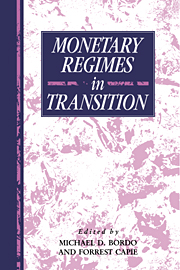Book contents
- Frontmatter
- Contents
- List of figures
- List of tables
- List of contributors
- 1 Introduction
- Part I Commodity money standards in transition
- Part II Successful and unsuccessful adherence to the gold standard
- Part III Wartime upheaval and postwar stabilization
- Part IV Perspectives on monetary regimes
- 12 An assessment of monetary regimes
- Index
12 - An assessment of monetary regimes
Published online by Cambridge University Press: 05 May 2010
- Frontmatter
- Contents
- List of figures
- List of tables
- List of contributors
- 1 Introduction
- Part I Commodity money standards in transition
- Part II Successful and unsuccessful adherence to the gold standard
- Part III Wartime upheaval and postwar stabilization
- Part IV Perspectives on monetary regimes
- 12 An assessment of monetary regimes
- Index
Summary
Introduction
Is there a common denominator for the varied monetary regimes that the chapters in this volume deal with? More than a dozen countries figure in the papers, most of them during periods when their monetary regimes were commodity-based, some of them (England, France, 1789–1821; the United States 1862–78; Hungary, 1921–28; Italy, France, 1945–49) at other periods when they either suspended or were seeking to re-establish commodity standards, and finally one country (Sweden, 1939–89) whose monetary regime is tracked over 50 years under fixed and floating exchange rates. The common denominator that I propose is the degree of success each regime experienced in maintaining actual and expected price stability. This is not necessarily the perspective of the authors of the chapters. In commenting on their contributions, I note their focus before assessing the price performance of the monetary regimes they deal with. The section headings I use are my own.
Commodity money standards in transition
Gallarotti and Redish in chapters 2 and 3 provide complementary descriptions of the forces that accounted for the switch to gold in the second half of the nineteenth century.
For Redish, a fall in the price of gold had created by 1860 a de facto gold standard in the bimetallic monetary regimes of Belgium, Switzerland, and France. While de facto monometallism had occurred in the past and had occasioned changes in the mint ratio, this time no change in the mint ratio was made. Instead these countries and Italy introduced a token silver coinage to provide small-denomination currency, and the Latin Monetary Union, which they organized in 1865, agreed on a uniform token silver circulation.
- Type
- Chapter
- Information
- Monetary Regimes in Transition , pp. 373 - 383Publisher: Cambridge University PressPrint publication year: 1993



